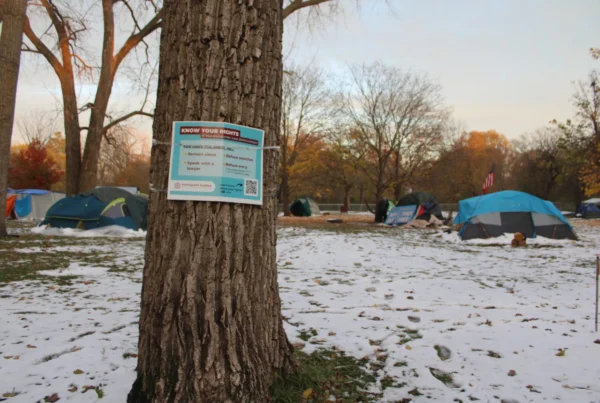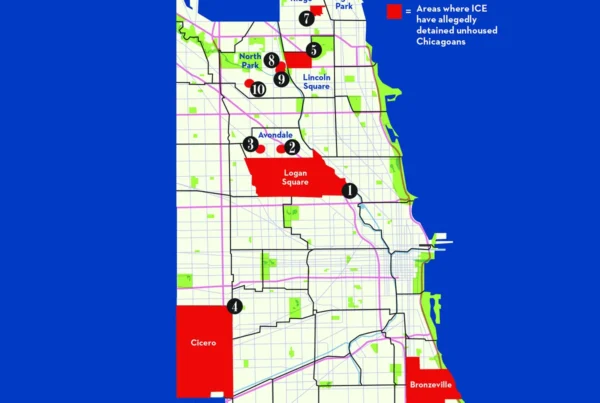January 29, 1999
By Cindy Richards and Diane Struzzi
Three months after saying the fences it built along Lower Wacker Drive were not aimed at ridding the area of homeless people, the city has served notice that they will be evicted as of 6 p.m. Friday.
The fences that enclose the sidewalks and loading docks where the homeless sleep will be closed and locked for the first time Friday evening. From then on, the gates will be locked nightly from 6 p.m. to 6 a.m., Assistant Corporation Counsel Alan H. Neff told attorneys for the homeless in a recent letter.
City officials had maintained in late October that they were fencing in the parking areas along the south side of Lower Wacker, ostensibly at the request of building owners, to deal with the problem of illegally parked cars.
And since then, the fence gates have stood open and unlocked, with the homeless continuing to camp out on the sidewalks near heating grates.
Several homeless men who still live on Lower Wacker said city workers or police told them over the past couple of weeks that they would have to move by 6 p.m. Friday. The men said they assume anything they can’t carry with them will be discarded.
But Friday’s planned lockdown won’t proceed without protest.
The Chicago Coalition for the Homeless has invited Chicago icon and historian Studs Terkel to address a vigil at LaSalle Street and Lower Wacker Drive when the lockdown commences at 6 p.m. Friday.
Terkel said he will denounce the move to “evict people from a public space where they have been for years, where they disturbed nobody. What is happening to us as humans?”
Indeed, people have been living under Wacker Drive virtually since it opened in 1926. During the Great Depression, the street was home to thousands of jobless men who dubbed it “Hoover Hotel,” after President Herbert Hoover, whom they blamed for their plight.
Neither the building owners nor the city is taking responsibility for planning Friday’s coordinated lockdown, but if the plan moves the homeless elsewhere, the lockdown clearly will achieve the goals of both.
The city has been trying for years to rid Wacker Drive of its persistent homeless population. Their efforts have been thwarted by homeless advocates who called in the media or filed lawsuits to stop them.
Building owners, meanwhile, have continued to complain about the filth that homeless residents leave on their loading docks and the fear of tenants who have to pick their way past cardboard homes, empty liquor bottles and leering stares to get into the buildings.
With the fences, the city and the building owners appear to have hit on a solution that might work for both.
But homeless advocates had hoped for another answer.
“Instead of solving the problem, they’re moving people out. It’s just moving the furniture around,” said John Donahue, executive director of the coalition.
Donahue said his organization had hoped to ask building owners to contribute $80,000 to a fund to provide temporary housing for the 80 or so people who regularly sleep on Lower Wacker. Once they have housing, they could get other assistance like intensive mental-health or substance-abuse services and job training, Donahue said.
The proposal also suggested that the building owners hire 15 of the homeless–perhaps using them as gatekeepers or maintenance workers for the now-private spaces enclosed by the fences.
The more than 20 building owners paid sums ranging from $500 to $7,000 each to obtain city permits that grant them control over the fenced-in property.
Those permits were issued earlier this month, but the gates remained unlocked while building owners and the city negotiated the details of the new system, said Paul Colgan, a spokesman for the building owners’ association.
One of the street’s residents, Woodrow Wilson, who has lived there for a year and a half, said he plans to stay right where he is. But that may not be possible.
Armed with their “public way use permits,” the building owners can have their security forces remove trespassers, or they can call on the Chicago police to enforce their newly granted property rights.
Wilson said police told him any homeless people still on Lower Wacker Friday night would be hauled off to jail.
Wilson said workers with the city Department of Human Services told him that if he showed up at a West Side address, they would find him a room at the YMCA. But without an income, Wilson said he believes he’ll be sent to Haymarket House, a rehabilitation center–a place he doesn’t want to go. He was offered no other options, Wilson said.
“They’ll just have to take us to jail,” he said, resting in his bedroll Thursday morning.
Romell Smith, 36, who has lived on Lower Wacker for the last nine months, likely will move temporarily to his sister’s home in Elgin.
“They say they’re not doing it because we’re homeless, but because the cars are parked down here,” he said.
Meanwhile, lawyers for the Lower Wacker residents and the city are nearing a settlement on a lawsuit filed last year over a particularly aggressive sweep of the area by Streets and Sanitation workers in December 1997. Under the terms of a proposed settlement, the city would pay $45,000 to compensate residents for possessions lost during the sweep. The deal also was expected to set guidelines for future cleanups.
But the cleanup agreement could be moot after Friday. As building owners take control of the formerly public space, they also take responsibility for keeping it clean, relieving the city of any further responsibility.






